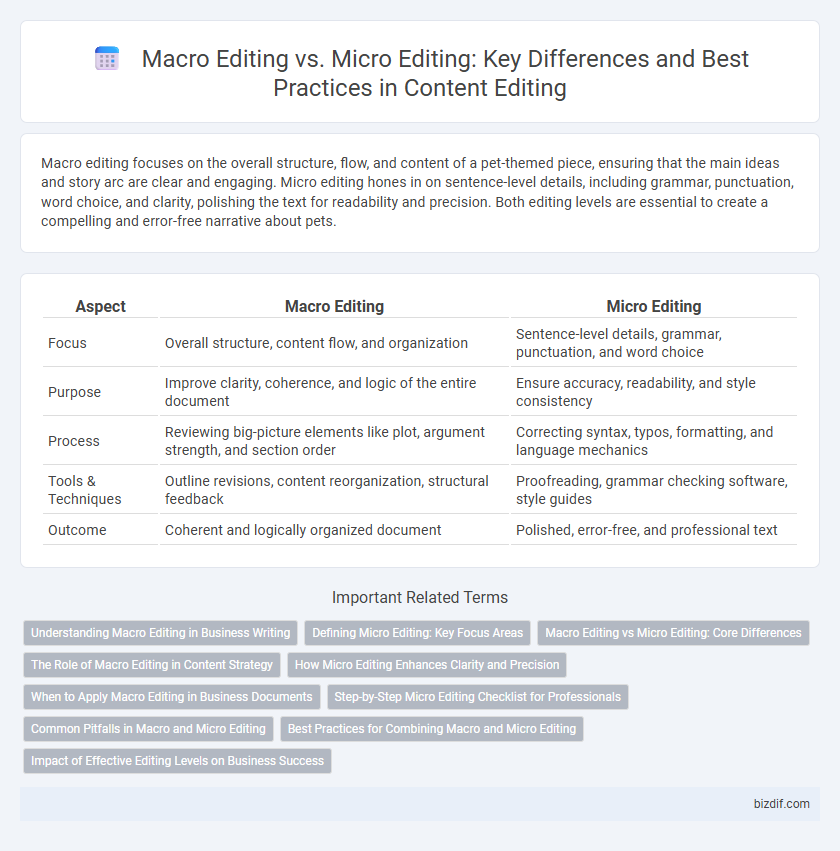Macro editing focuses on the overall structure, flow, and content of a pet-themed piece, ensuring that the main ideas and story arc are clear and engaging. Micro editing hones in on sentence-level details, including grammar, punctuation, word choice, and clarity, polishing the text for readability and precision. Both editing levels are essential to create a compelling and error-free narrative about pets.
Table of Comparison
| Aspect | Macro Editing | Micro Editing |
|---|---|---|
| Focus | Overall structure, content flow, and organization | Sentence-level details, grammar, punctuation, and word choice |
| Purpose | Improve clarity, coherence, and logic of the entire document | Ensure accuracy, readability, and style consistency |
| Process | Reviewing big-picture elements like plot, argument strength, and section order | Correcting syntax, typos, formatting, and language mechanics |
| Tools & Techniques | Outline revisions, content reorganization, structural feedback | Proofreading, grammar checking software, style guides |
| Outcome | Coherent and logically organized document | Polished, error-free, and professional text |
Understanding Macro Editing in Business Writing
Macro editing in business writing focuses on the overall structure, clarity, and flow of the document, ensuring the main message aligns with organizational goals and audience expectations. It involves evaluating content relevance, logical sequencing, and consistency in tone to enhance communication effectiveness. Emphasizing macro editing helps businesses avoid misunderstandings and streamline decision-making processes by delivering clear, purposeful messages.
Defining Micro Editing: Key Focus Areas
Micro editing concentrates on refining sentence structure, grammar, punctuation, and word choice to enhance clarity and readability. It addresses detailed aspects such as correcting typos, ensuring consistent tense, and improving syntax for precise communication. This level of editing is essential for polishing the text to maintain professional quality and reader engagement.
Macro Editing vs Micro Editing: Core Differences
Macro editing focuses on the overall structure, content flow, and big-picture elements of a document, ensuring coherence and logical progression across sections. Micro editing targets sentence-level details such as grammar, punctuation, word choice, and syntax to enhance clarity and readability. The core difference lies in macro editing shaping the framework while micro editing polishes the language within that framework.
The Role of Macro Editing in Content Strategy
Macro editing plays a crucial role in content strategy by shaping the overall structure, flow, and coherence of a piece, ensuring alignment with strategic goals and target audience expectations. It involves evaluating content scope, organization, and key messaging to enhance clarity and impact before focusing on finer details. Effective macro editing maximizes engagement and drives consistent brand messaging across multiple platforms.
How Micro Editing Enhances Clarity and Precision
Micro editing enhances clarity and precision by focusing on detailed elements such as sentence structure, word choice, and punctuation to ensure the text communicates the intended message effectively. This meticulous approach eliminates ambiguities, corrects grammar errors, and refines tone, making each sentence clear and impactful. By addressing these finer points, micro editing polishes the content, facilitating a smooth reading experience and reinforcing the overall quality of the writing.
When to Apply Macro Editing in Business Documents
Macro editing is essential during the initial review of business documents to ensure overall structure, clarity, and coherence align with organizational goals and target audience needs. Applying macro editing early helps identify large-scale issues such as poor organization, missing information, or irrelevant content that can impact the document's effectiveness. This process improves the logical flow and strengthens key messages before focusing on detailed sentence-level corrections through micro editing.
Step-by-Step Micro Editing Checklist for Professionals
Macro editing focuses on the overall structure, content flow, and coherence of a document, while micro editing targets detailed sentence-level corrections like grammar, punctuation, and word choice. A Step-by-Step Micro Editing Checklist for Professionals includes reviewing sentence clarity, correcting syntax errors, ensuring consistent tone, and verifying correct usage of technical terms. This approach enhances readability and precision, making the text polished and error-free for expert-level communication.
Common Pitfalls in Macro and Micro Editing
Common pitfalls in macro editing include neglecting overall structure and coherence, which can lead to a disjointed narrative or unclear argument. In micro editing, frequent mistakes involve overlooking grammar, punctuation, and word choice errors, resulting in reduced readability and professionalism. Both editing levels require careful attention to maintain clarity, flow, and effective communication throughout the text.
Best Practices for Combining Macro and Micro Editing
Effective editing balances macro editing, which focuses on overall structure, content flow, and big-picture coherence, with micro editing that scrutinizes grammar, punctuation, and word choice. Best practices for combining these approaches involve first addressing macro issues to ensure logical organization and clarity, followed by micro editing to polish language details and enhance readability. Integrating both layers creates a comprehensive, polished manuscript that maintains narrative consistency while refining linguistic precision.
Impact of Effective Editing Levels on Business Success
Macro editing enhances overall content structure and clarity, directly influencing brand messaging and audience engagement, which drives higher conversion rates. Micro editing ensures error-free, polished text that builds trust and professionalism, critical for maintaining customer loyalty. Combining both editing levels maximizes communication effectiveness, boosting business reputation and competitive advantage.
Macro editing vs Micro editing Infographic

 bizdif.com
bizdif.com